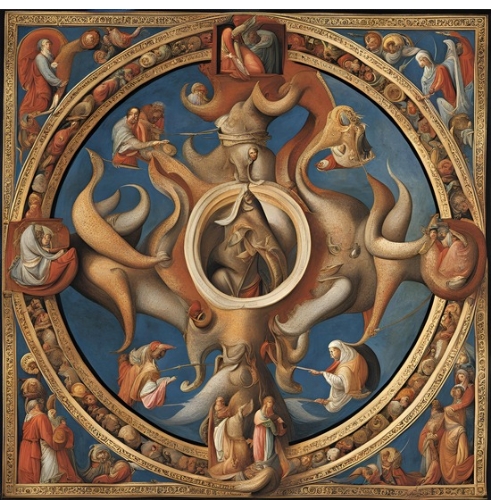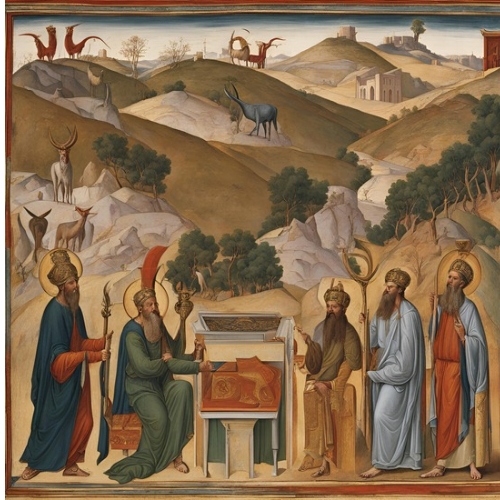THE FOUR HORNS: A PROPHETIC SYMBOL OF POWER AND JUDGMENT

The concept of the "four horns" is an important prophetic image that appears in several places throughout the Bible. These four horns represent significant spiritual and political powers that have shaped the course of history, and their study can provide valuable insights into God's plan for the world.
THE SIGNIFICANCE OF HORNS IN THE BIBLE
In the Bible, horns are often used as a symbol of power, strength, and authority. This symbolic usage stems from the nature of actual animal horns, which are formidable weapons used by many creatures for defense, dominance, and aggression.
For example, the book of Daniel describes a vision of a ram with two horns, representing the Medo-Persian empire (Daniel 8:3-4, 20). Later, the vision depicts a male goat with a prominent horn, symbolizing the rise of the Greek empire under Alexander the Great (Daniel 8:5-8). In these cases, the horns represent the military might and political power of these ancient kingdoms.
Horns are also associated with kingly authority and divine judgment. The psalmist sings, "All the horns of the wicked I will cut off, but the horns of the righteous shall be lifted up" (Psalm 75:10), conveying the idea that God will ultimately overthrow the power of the ungodly and exalt the righteous. Similarly, the book of Revelation describes a vision of a lamb with seven horns, representing the full power and authority of Christ (Revelation 5:6).
THE FOUR HORNS IN ZECHARIAH'S VISION
The specific phrase "four horns" appears in the book of Zechariah, where the prophet receives a vision from God:
"Then I lifted my eyes and saw, and behold, four horns! And I said to the angel who talked with me, 'What are these?' And he answered me, 'These are the horns that have scattered Judah, Israel, and Jerusalem.'" (Zechariah 1:18-19)
In this vision, Zechariah sees four horns, which the angel explains represent the powers that have "scattered" the people of Judah, Israel, and Jerusalem. This suggests that these four horns represent forces of judgment and oppression against God's people.
Later in the book, Zechariah receives another vision, this time of four craftsmen:
"Then I lifted my eyes and saw, and behold, four craftsmen! And I said, 'What are these coming to do?' He answered, 'These are the horns that scattered Judah, so that no one raised his head. And these have come to terrify them, to cast down the horns of the nations who lifted up their horns against the land of Judah to scatter it.'" (Zechariah 1:20-21)
In this second vision, the four craftsmen are depicted as coming to "terrify" and "cast down" the four horns that had previously scattered Judah. This suggests that the four horns represent powerful forces that will ultimately be overthrown by God's sovereign plan.
The specific identity of the "four horns" has been a subject of much discussion and debate among biblical scholars. However, several interpretations have emerged that provide valuable insights:
1. THE FOUR GREAT EMPIRES: Many interpreters see the four horns as representing the four great world empires that dominated the ancient Near East: Babylon, Persia, Greece, and Rome. These empires all played a significant role in the history of God's people, often as instruments of judgment and oppression.
2. SPIRITUAL POWERS: Others have suggested that the four horns represent powerful spiritual forces or demonic principalities that have worked to undermine God's purposes in the world. This interpretation aligns with the biblical teaching about the spiritual warfare that believers face (Ephesians 6:12).
3. SPECIFIC HISTORICAL EVENTS: Some scholars have attempted to identify the four horns with specific historical events or powers that threatened the people of God, such as the Assyrian, Babylonian, Persian, and Greek empires.
Regardless of the precise identification of the four horns, the overarching message of Zechariah's visions is clear: God is sovereign and will ultimately triumph over the powers that seek to scatter and oppress His people. The four craftsmen, sent by God, will "terrify" and "cast down" the horns, signifying that the judgment and oppression of God's people will not last forever.
THE FOUR HORNS IN THE BOOK OF REVELATION
The concept of the four horns also appears in the book of Revelation, where it is used to depict the power and judgment of God:
"Then I saw the Lamb open one of the seven seals, and I heard one of the four living creatures say with a voice like thunder, 'Come!' And I looked, and behold, a white horse! And its rider had a bow, and a crown was given to him, and he came out conquering, and to conquer." (Revelation 6:1-2)
In this passage, the four living creatures, which represent the full power and majesty of God, summon the four horsemen of the apocalypse. The first horseman, riding a white horse, is often interpreted as a symbol of conquest and judgment.
Later in the book of Revelation, the imagery of the four horns is used again:
"Then I saw another sign in heaven, great and amazing: seven angels with seven plagues, which are the last, for with them the wrath of God is finished." (Revelation 15:1)
These seven angels with seven plagues are depicted as emerging from the "four horns of the golden altar that is before God" (Revelation 9:13). This suggests that the four horns represent the source of God's final, righteous judgment upon the earth.

THE PROPHETIC SIGNIFICANCE OF THE FOUR HORNS
The recurring theme of the four horns in Scripture points to their profound prophetic significance. While the specific identities of the four horns may be debated, the overall message is clear:
1. THE FOUR HORNS REPRESENT POWERFUL, OPPRESSIVE FORCES: Whether they are earthly empires, spiritual principalities, or specific historical events, the four horns symbolize formidable powers that have sought to scatter, oppress, and undermine God's people throughout history.
2. GOD IS SOVEREIGN AND WILL JUDGE THE FOUR HORNS: Despite the apparent strength and dominance of the four horns, the visions of Zechariah and Revelation make it clear that God is ultimately in control. He will raise up "craftsmen" or "angels with plagues" to "terrify" and "cast down" the four horns, demonstrating His sovereign power and righteous judgment.
3. THE FOUR HORNS POINT TO THE FINAL CONFLICT: The imagery of the four horns, particularly in the book of Revelation, suggests that they are linked to the end times and the final conflict between the forces of good and evil. As God's people face increasing opposition and persecution, they can take comfort in the knowledge that God will ultimately triumph over all earthly and spiritual powers that seek to oppose Him.
4. THE FOUR HORNS HIGHLIGHT THE NEED FOR VIGILANCE AND STEADFASTNESS: The repeated warnings about the four horns serve as a call for God's people to remain vigilant, to stand firm in their faith, and to trust in God's sovereign plan. Even in the face of overwhelming adversity and persecution, believers can take courage knowing that God is in control and will ultimately vindicate His people.
The four horns are a powerful prophetic symbol that remind us of the ongoing spiritual battle between the forces of good and evil, and the sovereignty of God in ultimately judging and overcoming all those who seek to oppose Him and His people.

